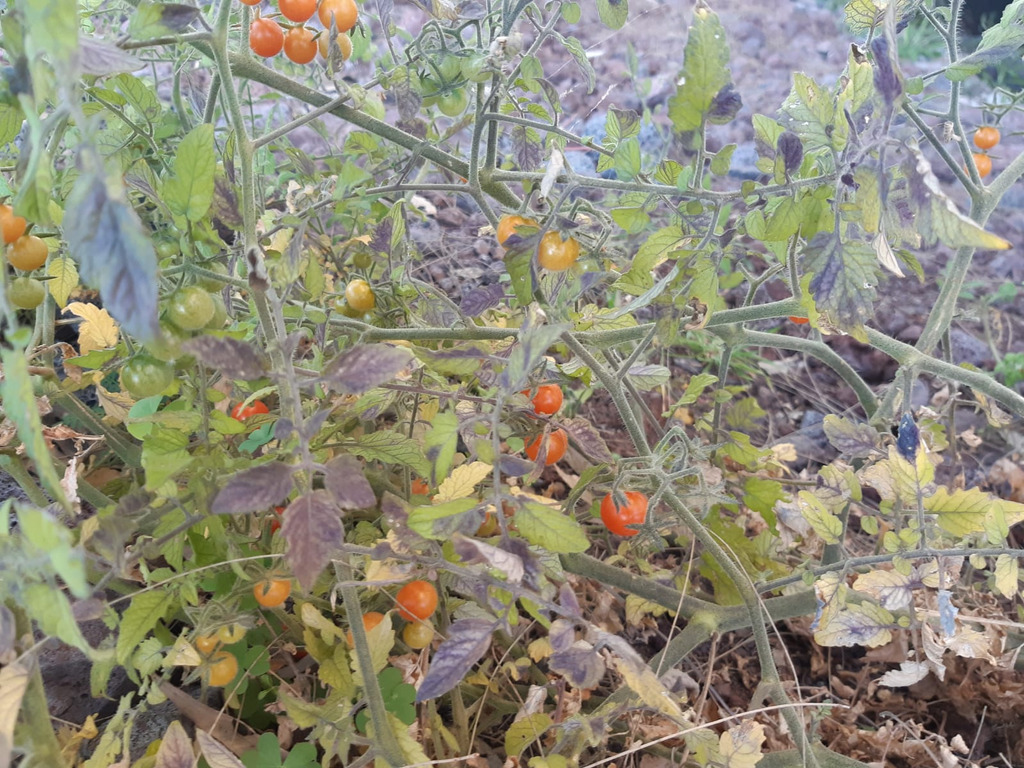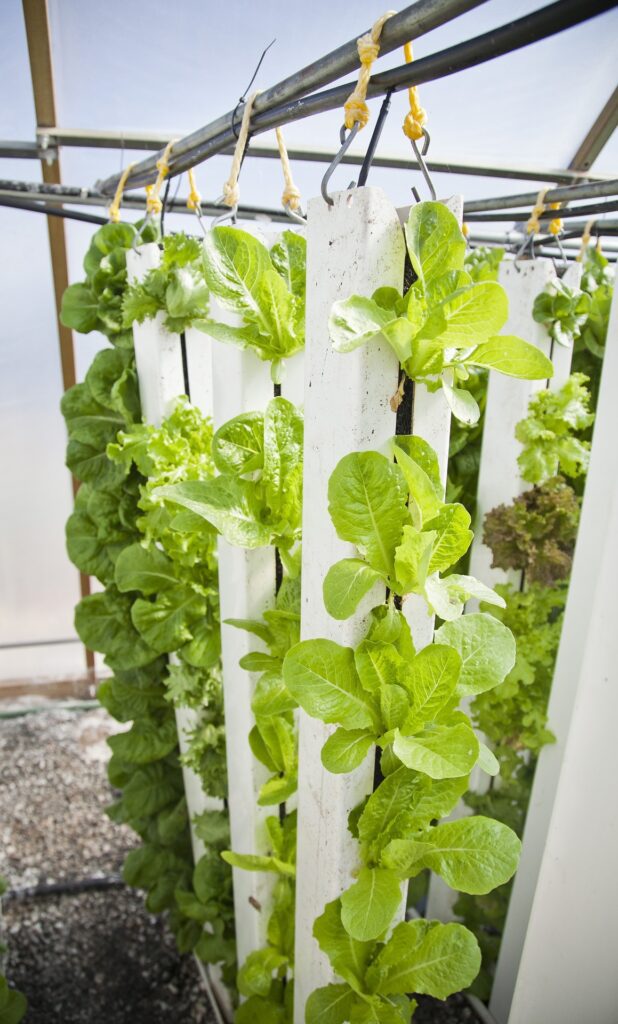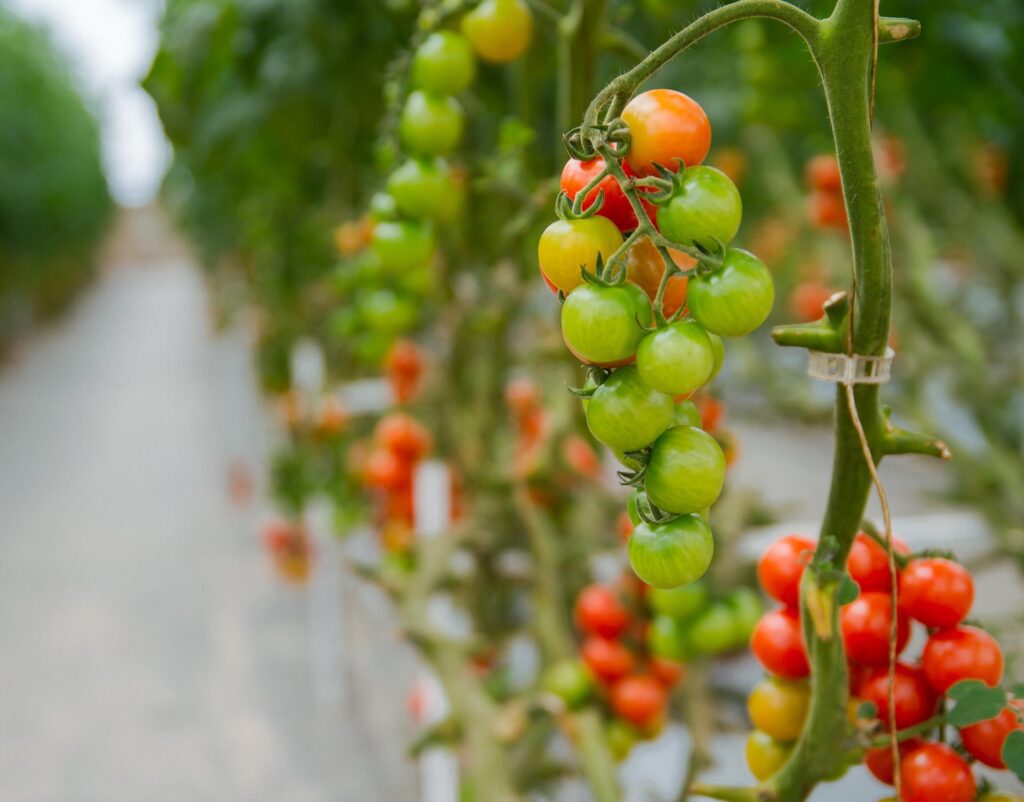Tomato Farming: How To Plant, Grow, Care
Tomato is one of the most widely grown vegetables in the world. In every cuisine, tomatoes hold the utmost importance due to their various uses and nutritional value. Therefore, tomato is amongst the most popular vegetable around the world.
Furthermore, the crop is acclimatized to different climatic conditions and a wide range of soils. The following article will help you, understand more about Tomato as a crop and also guide beginners to understand Tomato Farming techniques.

The botanical name for tomato is Solanum lycopersicum and it belongs to the Solanaceae family. The chromosomal number of tomatoes is 2n=24. Tomato is a native of Mexico and was 1st found on record in the year 1554 in South America. Tomato is a warm-season crop and it requires a warm and cool climate for better fruit production. Adverse climatic conditions such as frost, high humidity, and temperature below 10°C and above 35°C affect the tissues of the plant resulting in the slow physiological activity of the plant.
Pigmentation in tomato
Description of Important parts of Tomato plant
- Roots– The plant has a tap root system.
- Stem– The stem is hairy and glandular with an erect growing habit. The height of the variety usually depends upon the variety, but in general, tomato plant grows 2-4cm long.
- Leaves– Tomato plant has compound leaves with small leaflets. The main leaflet is long, ovate, and oblong with irregular margins.
- Fruits– The color of the fruits are initially green when immature but after maturity, the color turns red. The fruit type is ‘berry’, round, globular with a fleshy pericarp.
- Flowers– The flowers are perfectly hypogynous i.e. the presence of stamens and floral parts below the carpel.
- Seeds– The shape of the seeds is kidney-shaped or pear-shaped and light brown in color.
Like this: Dahlias plant, grow and care
Importance of Tomatoes and Tomato Farming
- Tomatoes are a source of antioxidant lycopene that helps reduce the risk of cancer and heart-related diseases. Lycopene and beta-carotene are rich antioxidants that protect the eyes from damage due to light as well as reduce the chances of the development of cataracts. Therefore, tomatoes are also known as “Protective fruits”.
- Tomatoes are known to be a good source of fiber along with being low in carbs. Tomatoes in a green stage can be used as vegetables as they are rich in Vitamin K which also helps in blood clotting.
- They are also a great source of vitamins and minerals. Tomato contains Vitamin C, Potassium, and Folate (Vitamin B9) in good amounts.
- Tomatoes being high in water content helps in staying hydrated and constipation free. Thus, they are also known as ‘Laxative fruits’.
- Tomatoes are very versatile fruits. They can be eaten raw as salads, in sandwiches, or as a top dressing and can also be added to different dishes to enhance their flavor and color.
- The initial investment to start the business is not much. Therefore, even small farmers can with the field start commercial tomato farming.
- Tomatoes are the fruits that are around the year in demand throughout the world. So, their demand in domestic as well as International markets will never decrease.
- Value-added products such as Ketchup, sauces, soup, chutney, etc. can be made out of tomatoes. And, this makes the tomato business very profitable and lucrative.
Production Technology of Tomato
Climatic conditions of tomato farming
Tomato requires a warm and cool climate. The optimum temperature for the cultivation of tomatoes is 20°C- 24°C. Temperature below 10°C and above 30°C could affect the physiological growth of the plant. Tomato plants cannot tolerate high humidity and frost conditions. The intensity of the light also affects the pigmentation in the fruit. Above 27°C the production of pigment rapidly drops.
Soil type in tomato farming
Tomatoes grow well in a vast range of soils. They prefer deep, well-drained, loamy soils. The ideal pH of the soil is 6.0-7.0. Deep tillage in heavy soils rich in organic matter allows adequate root penetration resulting in better production.
Time of Planting and season
The tomato crop can be grown in any season as it is a day-neutral crop. In the Northern plains, the sowing season is Kharif season- July, Rabi season- October- November, and Zaid- February.
Note- In frost-affected areas, the Rabi season tomato crop remains unfruitful.
In Southern plains, 1st sowing is done in January, 2nd sowing in June-July, and 3rd sowing in September- October, only in areas unaffected by frost.
Nursery preparation
a) Plough the field well.
b) Apply well-rotten Farmyard Manure (FYM) @25tonne/hectare at land preparation.
c) Castor cake/ Calotropis cake/ Neem cake @ 100kg can be applied to the soil.
d) Now, prepare 3-4m long, 120cm wide raised beds with 15cm height to avoid water logging in the nursery.
Seed and Sowing in tomato farming
For sowing purposes, make sure the seeds are disease-free, healthy, and viable.
Varieties of Tomatoes for farming
Open-pollinated varieties include Arka Meghali, Arka Alok, Arka Abha, Arka Ashish, Solan Gola, and Paiyur 1
Hybrids include Pusa Hybrid 1, Pusa Hybrid 2, Pusa Hybrid 4, Arka Vardan, Pusa Sadabahar etc.
- Seed rate- For Open Pollinated varieties- 300-350g seeds/hectare. And for Hybrids, 150-200g seeds/hectare are required.
- Seed Treatment– Seeds should be treated before sowing with Captan/Thiram @2g/Kg of seeds for reducing the chances of disease instances.
- Seeding sowing– Seeds should be placed at 2-3cm in depth in the soil and then covered with light soil. Straw can also be used for mulching for the seeds to get the optimum temperature and humidity for germination along with reducing the emergence of weeds in the nursery.
Nursery Management
a) Irrigating the nursery twice a day is important for the timely germination of the seedlings.
b) After the germination of seedlings, remove the straw.
Land Preparation for Transplanting
i) Plough the field 4-5 times with adequate time intervals between two ploughings.
ii) Planking is a must for leveling the field before transplanting.
ii) Add well decomposed FYM @ 25tonne/hectare in the field.
Transplanting in tomato farming
a) Seedlings are either transplanted in flatbeds or shallow furrows.
b) In case of heavy soils transplant seedlings in ridges and this also helps in the rainy season as well.
c) Generally, the seedlings are transplanted in 10-14 days of germination when they have 5-6 leaves and their stem starts hardening a little.
Manure and Fertilizers
During planting application of 60Kg N, 8Kg P2O5, and 50Kg K2O should be done. And other half N should be applied as a top dressing after 30 days of germination.
Irrigation
a) Light irrigation should be done after 2-3 days of sowing.
b) Irrigation mostly depends upon the soil but in general, the field should be irrigated in weekly intervals.
c) Cracking of fruit is a problem caused due to irrigating the crop after a prolonged dry spell. Hence, this should be prevented anyhow.
d) Critical period of Irrigation is the Flowering and Fruit development stage. Therefore, water stress during this period could affect crop production.
Intercultural Operations in tomato farming
a) Weeding
In the initial growth stages, the field should be weed free as during this time period there is high competition between the seedlings and weeds for food, sunlight, and water. And in long run, these weeds become the reason for low crop yield and even crop failure. Hoeing and earthing up are important for removing weeds from the field. Pre-emergence application of weedicide such as Pendimethalin @ 1Kg a.i./hectare is effective for the control of weeds. Along with it, mulching can also be done for preventing weed infestation in the crop.
b) Staking
The varieties of tomatoes that grow long need support. Therefore, staking is important. After 3-4 weeks of transplanting, staking can be done. Staking should be provided using strings, wires, or sticks. It helps the plant to restrict its fruit from getting exposed to water and soil so that fruit rotting is prevented timely. Stacking also helps to perform intercultural operations in the field. Thus, it helps maintain the quality of fruits.
Harvesting
Harvesting of the tomato depends on the variety sown. But, generally, the harvesting usually starts 75-90 days from planting. There are different stages of harvesting tomatoes depending on the transport mode, market distance, etc.
- Green Stage– For long distant markets, the tomatoes are harvested in the green stage.
- Pink Stage– For shorter distances, the tomatoes are harvested in this stage when the color changes from green to pinkish.
- Maturity Stage– For selling tomatoes in local markets, they are harvested in this stage when the fruit turns reddish.
- Full Maturity– In this stage, the fruit becomes slightly red on the tree. And they are suitable for making valuable products such as chutney, sauce, soup, etc.
Further, grading and packing are done to transport the harvest to the market.
Yield
The yield of the crop depends upon the variety of tomatoes and the incidences of insects, pests, and diseases in the crop. On average, the yield of tomatoes varies from 20-25t/ha.
Pests in Tomato farming
Fruit Borer
The scientific name for the pest is Helicoverpa armigera (Hubner). The female lays eggs on flowers and feeds on leaves and then fruits. They make a hole in the fruit and get half inside the fruit. It could damage half of the yield if not controlled timely.
Whiteflies
Whiteflies are known to be responsible for transmitting the Leaf curl virus. They suck food from the leaves leaving young leaves to deform. For management, use traps such as yellow sticky traps for catching them.
Root-Knot Nematodes
The nutrient and water uptake capacity of the plant is affected resulting in stunted growth with yellow foliage of the plant. For control, use a nematode-resistant tomato variety. Seed treatment and application of Carbofuran could help.
Diseases in Tomato farming
Powdery Mildew
The symptoms of the disease include the appearance of white chalky spots on leaves turning the leaves yellow, dying, and dropping off. Always select disease-free, healthy seeds for crop production, and also make sure not to apply fertilizer in excess to the crop for it to be disease free.
Damping off
This disease occurs during the seedling stage. It is very common in nurseries during the pre-emergence stage where young seedlings die before reaching the soil surface. The disease leads to a weak stem and then collapse. For management, avoid poor drainage soil and raised bed techniques to be used to avoid the collection of water around.
Alternaria Blight
Necrotic spots with dark brown centers appear on leaves along with lesions on the stem. Maintain proper irrigation, management of pests, and favorable growing conditions for the control of the disease.
Vertical tomato farming
Due to the increase in population, there is an increase in the demand for crop production. Therefore, to meet the demand of the ever-growing population, Vertical Farming and Hydroponics come into the picture. Let’s discuss what Vertical Farming and Hydroponics are and what are the benefits of these farming methods.

Vertical Farming refers to the method of growing crops in vertically layered stacks under controlled conditions. It is simply a method to grow tomatoes indoors so that farmers could produce the crop, around the year proving favorable conditions for the crop to grow.
Benefits of Vertical Farming
- Vertical farming allows farmers to grow higher yields per square foot than the traditional method we have been using for years.
- It helps in the efficient use of land and available resources enhancing crop production.
- Vertical Farming helps the farmers to grow crops under favorable conditions so that around the year tomatoes are produced to meet the market demand. This further helps in the stability of the prices of tomatoes regardless of the higher demands in the market.
Hydroponics
Hydroponics is a method that involves the production of tomatoes in nutrient-rich solution rather than soil and is placed in a non-soil material so that their roots are supported.

Benefits of Hydroponics
a) Production of tomatoes hydroponically allows faster growth of the crop than in soil.
b) In Hydroponics, there is an efficient use of nutrients and water uptake. Therefore, production increases multiple times.
c) Not growing the crop in the soil reduces the chances of soil-borne diseases, poor drainage situations, and various problems including soil pH, salinity, or soil that might reduce the crop yield.


